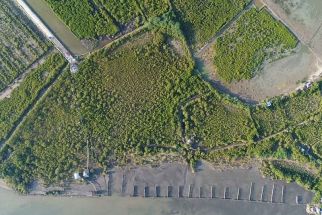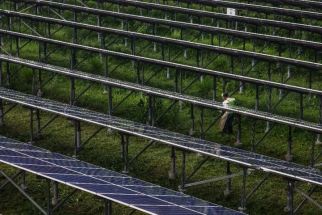Fossil gas expansion in Batangas seen to threaten marine corridor, coastal folk
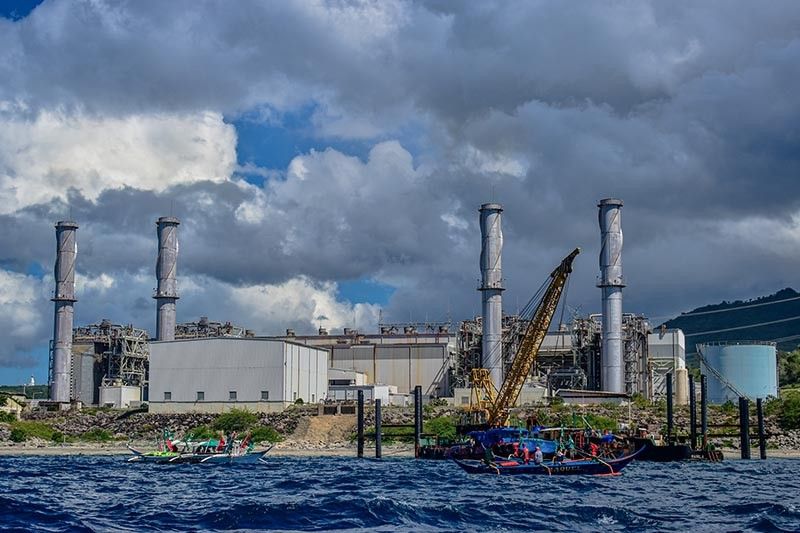
BATANGAS CITY, Philippines — Before Batangas City became the epicenter of the country’s fossil gas expansion, there was an abundance of fish in its waters, Yul Gilea, a fisherman from Mabini town said.
"Life was good. Fishing helped some of us send our children to universities," he said in Filipino.
But the 70-year-old said fisherfolk like himself get fewer fish as the Southern Luzon port city has become a site of fossil gas plants. Now, they catch only two to three kilograms of fish such as galunggong and tulingan after spending around six hours on the sea. On good days, they can catch as much as 10 kilograms.
Sometimes, boats venture out to the waters of Calatagan, where waves are bigger, in search of fish.
"We are lucky if neighbors buy our catch. But who will still buy our catch when we go home at 8 p.m., at a time when most families have finished eating their dinners?" Gilea asked.
To earn extra cash, he makes dried fish and sells them. But the business does not make a lot of money, Gilea said, adding the chunk of his earnings goes to transporting fish from the Central Luzon province of Bataan to Batangas, and to paying his workers.
Biodiversity rich
Gilea fishes in the Verde Island Passage (VIP), the strait that separates Batangas and Mindoro provinces. VIP is recognized as the center of global shore fish biodiversity, with roughly 1,736 marine fish species within a 10-kilometer area. It is also home to whale sharks, sea turtles, nudibranch, and an incredible array of corals.
The marine biodiversity conservation corridor has 36 marine protected areas.
But it is also a hotspot of massive fossil gas expansion. Five of the six existing gas plants in the Philippines are found in Batangas City, while one is in Cebu. Batangas province is also the site of eight proposed new plants and seven of the planned liquefied natural gas (LNG) terminals.
VIP has already sustained serious impacts from a decade of industrial development in the area. Climate change, illegal and destructive fishing practices, and unsustainable tourism also endanger its marine resources.
Locals and green groups fear that fossil gas and LNG projects will exacerbate the existing pressures in the marine ecosystems and threaten communities that rely on VIP resources to earn a living.
“People’s livelihoods are at risk—not only fisherfolk are affected but also resort owners,” Fr. Edwin Gariguez, lead convenor of the Protect VIP campaign network, told Philstar.com.
VIP is the main source of livelihood of more than two million people from five provinces—Batangas, Occidental Mindoro, Oriental Mindoro, Marinduque, and Romblon.
For example, Batangas generated 65,857.14 metric tons of total fisheries catch in 2020—the highest in Calabarzon. In 2019, however, the province had 93,090.69 metric tons of total fisheries catch.
Due to its proximity to capital Manila, Batangas is a go-to weekend getaway for city dwellers. Oriental Mindoro's Puerto Galera, known for its white sand beach and dive spots, is also one of the country's top tourist destinations.
Under threat
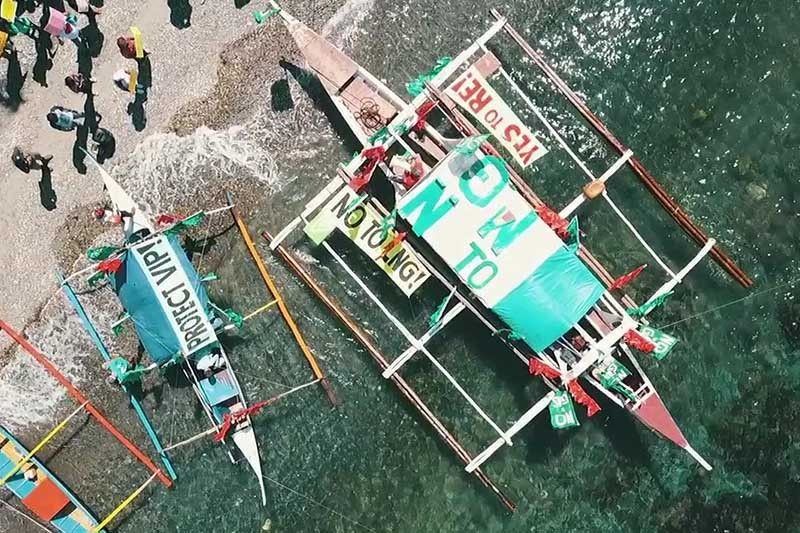
According to a marine ecology and water quality study conducted by the Center for Energy, Ecology, and Development (CEED), "very high" concentrations of toxic metals such chromium, copper, and lead have been detected along the coasts of Barangay Ilijan and Dela Paz in Batangas City.
High concentrations of those metals, and inorganic parameters such as phosphate and sulfate mean the area is no longer fit for boating and fishing, the organization said. Concentrations of mercury—a product of electrical power generation and industrial waste—in the area are also rising.
Ilijan and Dela Paz are the sites of an LNG terminal proposed by Linseed Field Power Corporation and Atlantic Gulf & Pacific Company (AG&P), and an adjacent 1,700 MW gas plant of San Miguel Corporation (SMC) subsidiary Excellent Energy Resources Inc (EERI).
A gas facility, which is maintained by KEPCO Ilijan Corporation, is also found in the same area.
The CEED study likewise found that the reef fronting the heavily industrialized areas in Ilijan and Dela Paz have very low coral cover ranging from 0.1% to 6.2%. It said the gas expansion will further disturb the already dwindling coral cover in the area.
The think-tank stressed that sea water intake and discharge from gas plants and terminals may affect water temperature—a limiting factor for the survival of fish and corals—and force fish to seek cooler water elsewhere.
It added the transportation of fossil gas will result in elevated shipping activities, which increase the risks of water pollution, underwater noise pollution, sedimentation, grounding of reefs, ship strikes, and damage to smaller vessels.
In its environment impact study, EERI said the operation of the proposed gas plant may lead to soil contamination due to spillage of fuel and chemicals, degradation of water quality, threats to abundance of corals, reef fish and other marine organisms, and deterioration of ambient air quality due to emissions.
Linseed, in its environmental impact report, mentioned the coastal impact area of the project site is part of the VIP. The study, however, did not significantly discuss the facility's impact on VIP's ecosystem.
Philstar.com has reached out to AG&P and SMC for their comments, but they have yet to respond.
Center of gas expansion
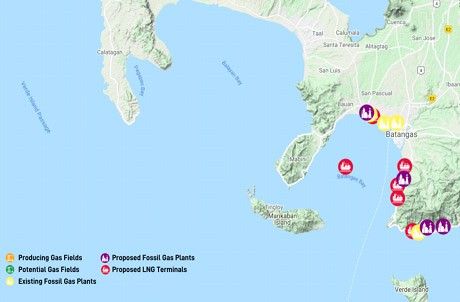
Aside from the Ilijan Power Plant, Batangas City is also the site of First Gen Corporation’s four gas-fired power plants: the 1000-MW Santa Rita, the 500-MW San Lorenzo, the 97-MW Avion, and the 420-MW San Gabriel plants. In 2021, the firm began the construction of a floating LNG terminal in the province.
The Department of Energy estimated the Malampaya deep water gas-to-power project in Palawan, which provides about 20% of the country’s power needs, will be depleted by 2027. The agency, led by Secretary Alfonso Cusi, is pushing to strengthen the development of a natural gas industry.
In its Philippine Energy Plan 2018 to 2040, the DOE said it intends to establish a “world-class, investment-driven and efficient natural gas industry to make it the preferred fuel for end-use subsectors.” In 2020, 19% of the country’s generated powercame from natural gas, while coal-fired and renewable energy accounted for 57% and 21% of the power mix, respectively.
While the Philippines currently has no operating LNG terminals that will receive LNG supply, the DOE is aiming to transform the country into a leading LNG hub in Asia.
Natural gas, just like coal and oil, is a fossil gas extracted from the Earth and burned in power generation plants. LNG is natural gas that has been cooled to a liquid state, making it easier to transport in very long distances.
While natural gas emits less carbon dioxide than coal, its extraction, transportation, liquefaction, and regasification result in the leakage of methane, a potent greenhouse gas. Its capacity to trap heat is 80 times more than carbon dioxide over a 20-year period.
Scientists warned in a report released by the Intergovernmental Panel on Climate Change in August 2021 that “strong, rapid and sustained reductions” in methane emissions are needed in addition to cutting carbon dioxide emissions in order to stave off catastrophic global warming.
‘Not a bridge, but a wall’
As the country begins to kick its coal habit, fossil gas is touted as a “bridge fuel” that can help the shift to a lower-carbon economy by supplementing intermittent renewables.
Vice President Leni Robredo, who is seeking to succeed President Rodrigo Duterte, sees LNG as a “practicable option” in the energy transition. But environmentalists like CEED stress that fossil gas developments only serve as a roadblock.
“It’s not a bridge. It’s a wall. You’re building a wall to prevent the transition of the Philippines from a fossil dependent energy system to renewable energy,” said Valentino De Guzman, CEED community empowerment and engagement program head and fossil gas campaign lead.
CEED also said that fossil gas is volatile and costly as gas-powered plants in the Philippines are likely to rely on imported LNG in the future.
“LNG is not a source of energy that will generate clean energy and provide energy security. The energy that will be generated is expensive because the supply is imported. It will also destroy the environment and contribute to climate change,” De Guzman said.
Protect VIP movement's Gariguez called on the government and the country's future leaders to make the shift to cheap and clean renewable energy an election issue. He also called for more investment in solar, wind and hydro instead of pushing for “dirty, deadly, and costly” coal and gas.
Philstar.com reached out to the DOE for its comments, but the agency has yet to respond.
Off their coasts
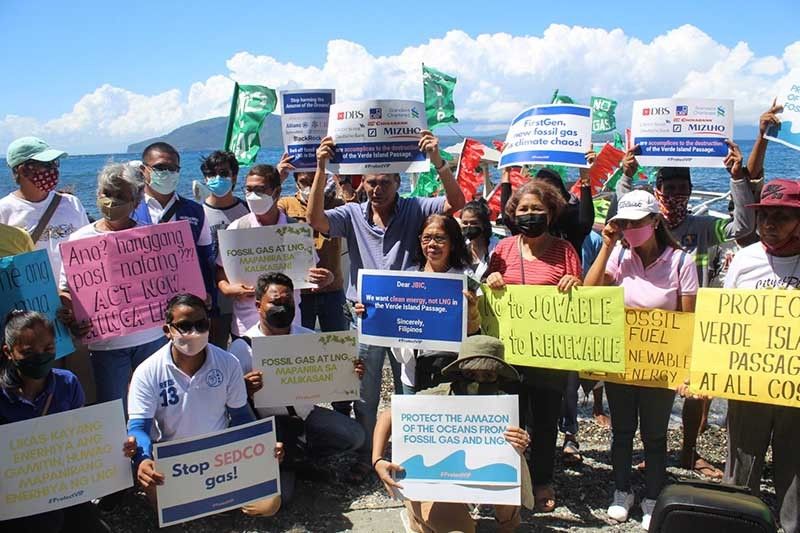
On Earth Day last April 22, Gilea, along with fisherfolk, locals and environment groups held a protest near the sites of planned plants to voice their opposition to the gas expansion.
“We believe that the gas plants will lead to the loss of our livelihood and the destruction of the environment. So far, there are only five plants in Batangas City, but fishers are already experiencing difficulties,” the vice chair of Bukluran ng Mangingisda ng Batangas said.
In 2021, the Protect VIP movement launched an online petition urging government agencies and local government units to protect the marine corridor, and halt the establishment of fossil gas plants and terminals in Batangas City.
The movement is a coalition of people's organizations, fisherfolk groups, hotel and resort operators, and the Catholic Church.
Years of resistance by communities and green groups led the country to ban the construction of new coal-powered generators. While the moratorium does not include previously approved projects that are already in the pipeline, the shift in policy is still a win for them.
CEED's De Guzman is hoping their campaign against gas and LNG projects will yield the same results. “Batangas folk once stood up against a planned coal plant. They will not hesitate to rise up again for the same reason.”
But for fisherman Gilea, the government—especially local authorities—should join them in resisting projects that will harm communities.
“They should pay attention to this huge problem that makes our lives more difficult. They should stand by our side in this struggle.”
--
This story was supported by Climate Tracker
- Latest























